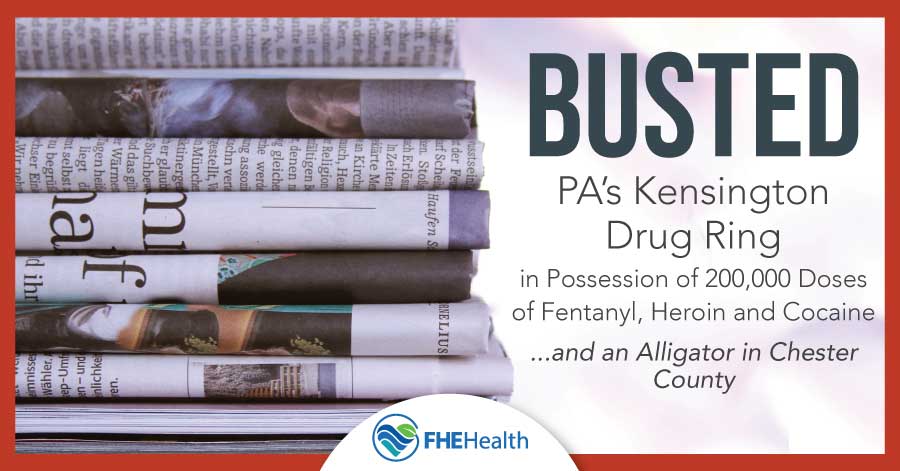
Law enforcement recently seized nearly 200,000 doses of heroin and fentanyl and arrested 11 individuals, during a big bust of a suspected multi-million dollar drug ring operating in the Kensington neighborhood of Philadelphia. Pennsylvania’s Attorney General Josh Shapiro announced the shutdown of this large drug trafficking operation in February 2019. The bust was the result of hard-working local, state and federal law enforcement agencies working together in an investigation that they dubbed “the Kensington Initiative.”
Charges against the 11 people included conspiracy, corrupt organizations, possession, and possession with intent to deliver narcotics. Over 160 officers and agents executed search warrants at 15 vehicles and 13 residences early in the morning to avoid detection by the alleged criminals.
Attorney General Shapiro’s office reported that the estimated value of the fentanyl and heroin seized was almost $8 million (or the rough equivalent of the drug ring’s annual revenue). In addition to fentanyl and heroin, law enforcement seized nearly 1,000 grams of crack cocaine with a street value of $98,000.
AG Shapiro has since released the following statement: “Our communities…cannot sustain this health crisis of opioid addiction and gun violence. As Pennsylvania’s chief law enforcement office, it is the job of the attorney general to target criminals involved in holding our neighborhoods hostage and deliver the justice they deserve. But we as a community must work together to develop and utilize solutions to prevent and treat drug addiction to benefit from lasting results.”
Another Drug Bust in Pennsylvania Turns Up an Unlikely Suspect
In another dramatic Pennsylvania drug bust, law enforcement stumbled upon a highly unlikely suspect. When Chester County police executed a search warrant on February 8 at a Coatesville residence, they seized fentanyl, crack cocaine, $5000 in cash, and materials used to package drugs.
They also found a two-foot long American alligator living in the kitchen of the home. The alligator has since been sent to Wilmington, Delaware’s Brandywine Zoo. The zoo reports the juvenile alligator will be available to view throughout the summer before it is transported to the Alligator Farm and Zoological Park in St. Augustine, Florida.
Law enforcement involved in drug busts often say they never know what they will find when executing a drug search warrant. In some cases, police may encounter an armed suspect, the frightened family of a big drug dealer who may not know anything about what the dealer is doing, or, in this instance, a live alligator.
Officers involved with the Coatesville drug raid said drug dealers typically try to reflect a menacing, threatening image, by keeping dangerous animals around like alligators, big snakes, pit bulls and even wild lions. They think this helps them protect their stash of drugs, guns and cash from people who might consider stealing them. In this case, however, not even a teethy gator was sufficient protection from a police search warrant.
How Does Heroin and Fentanyl Get Into Our Communities?
According to Politifact, most of the heroin and fentanyl fueling the opioid addiction crisis in the U.S. is manufactured and packaged in South American countries, Afghanistan and China where drug laws are not rigorously enforced. Drug rings involved in smuggling heroin and fentanyl to the U.S. then try to get drugs over the Mexico-U.S. border using drones, catapults, underground tunnels, drug “mules” and boats. In fact, nearly 230 tunnels were discovered by border patrol agents and ICE between 1990 and 2016. Dozens more are continuing to be discovered every year.
Fentanyl, an extremely powerful opioid responsible for thousands of overdose deaths each year in the U.S., primarily comes from China through the U.S. postal service, the Canadian-U.S. border and the southwest border.
The RAND Drug Policy Research Center, a leading nonpartisan research facility providing objective analyses and statistical research to policymakers, has reported that drug traffickers are rapidly developing innovative strategies to circumvent border walls and border control. RAND researchers have suggested that federal agencies overseeing detection and apprehension of drug cartels should utilize high-tech methods for intercepting fentanyl and other illegal opioids being sent via the U.S. postal service.There is also a need for increased manpower and more drug-sniffing dogs to successfully combat the flow of drugs into the U.S. from overseas countries and Mexican and U.S. drug traffickers.
What is Being Done to Help Opioid Addicts?
While law enforcement continues battling the tremendous flow of drugs into all U.S. states, federal, state and local communities are providing a variety of resources to prevent and treat addiction. Outpatient and inpatient treatment programs are the most successful types of treatment modalities, having helped many Americans find freedom from opiates and long-term recovery.
If you or someone you know is struggling with a drug addiction or mental illness, don’t hesitate to call us for immediate and compassionate help. You can contact us today by calling (833)596-3502. Our team of experienced counselors are standing by to take your call 24/7. Start your journey to recovery today, by taking that critical first step in asking for help.






